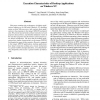Free Online Productivity Tools
i2Speak
i2Symbol
i2OCR
iTex2Img
iWeb2Print
iWeb2Shot
i2Type
iPdf2Split
iPdf2Merge
i2Bopomofo
i2Arabic
i2Style
i2Image
i2PDF
iLatex2Rtf
Sci2ools
91
Voted
ISCA
1998
IEEE
1998
IEEE
Execution Characteristics of Desktop Applications on Windows NT
This paper examines the performance of desktop applications running on the Microsoft Windows NT operating system on Intel x86 processors, and contrasts these applications to the programs in the integer SPEC95 benchmark suite. We present measurements of basic instruction set and program characteristics, and detailed simulation results of the way these programs use the memory system and processor branch architecture. We show that the desktop applications have similar characteristics to the integer SPEC95 benchmarks for many of these metrics. However, compared to the integer SPEC95 applications, desktop applications have larger instruction working sets, execute instructions in a greater number of unique functions, cross DLL boundaries frequently, and execute a greater number of indirect calls.
Desktop Applications | Hardware | Integer Spec95 Applications | Integer Spec95 Benchmarks | ISCA 1998 |
Related Content
| Added | 05 Aug 2010 |
| Updated | 05 Aug 2010 |
| Type | Conference |
| Year | 1998 |
| Where | ISCA |
| Authors | Dennis C. Lee, Patrick Crowley, Jean-Loup Baer, Thomas E. Anderson, Brian N. Bershad |
Comments (0)

